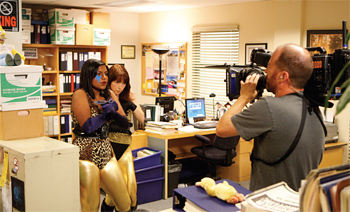'The Office' Online
LOS ANGELES
As any fan of NBC's "The Office" can tell you, episodes focus primarily on a handful of principal characters while the rest of the Dunder Mifflin employees play supporting roles or provide the occasional comment or reaction. But on the companion "Webisodes," supporting characters get the spotlight in brief (three- or four-part) series of two-minute-long episodes. The newest of these, "Subtle Sexuality," is a three-part series about the blissfully unaware and rather dimwitted Kelly Kapoor (Mindy Kaling) and her attempt to create a music video, dragging co-workers Erin (Ellie Kemper), Andy (Ed Helms), Kevin (Brian Baumgartner) and Ryan (B.J. Novak) into the process. Kapoor, a writer as well as a performer on "The Office," directed the Web series.

On "The Office" companion Webisodes, supporting characters get the spotlight in brief (three- or four-part) series of two-minute-long episodes. "The Webisodes are our way of promoting from within to show off our actors' versatility," says Randy Cordray, line producer on the TV show and producer of the Web series, including Kevin's "Bank Loan," "The Outburst" and now "Subtle Sexuality." "We've had actors or writers who've never directed get to direct. One of our first ADs directed a Web series that will come out in the spring."
SIMILAR LOOK
Conceptually, the Webisodes are expected to look like the series. Except for the absence of the series' top-billed talent, viewers are supposed to see them as supplementary episodes that look and feel like the show. The Webisodes are shot by the same crew that does the series and with all the same equipment. Cordray schedules a Web series—approximately eight minutes of finished material—in one day.
The producer explains that they don't use Webisodes to break in new talent in the crew. The same camera, lighting, grip and audio crews that do the series also work on the Webisodes. Randall Einhorn, who has both shot and directed episodes of "The Office," has also shot some of the Web series, as has Matt Sohn, another frequent cinematographer on the series. "We don't want to handicap a new director with people who are not familiar with our style of working," he says. "On the main unit of "The Office" we work very quickly. We shoot an average of eight or nine pages a day. And for a Webisode, we have to average 12 to 14."
As with the TV series, action is covered by two Sony F900s running untethered—allowing freedom of movement around the set. "They're not wired or cabled to a video village or a DIT station, so they can roam 360 degrees around the sat," says Cordray. "We use a microwaved signal to a monitor and DIT booth off the set."
Similarly, the actors have body mics to supplement the audio the boom operator can get. All the audio is sent wirelessly to a 24-track recorder. The set mixer will control levels for the primary dialogue as normal but also has ISO recordings from all the body mics to allow for greater control of the audio in post.
"We'll light for a scene and then roll the full 40 minutes of HDCAM tape without cutting between setups, unless there's a technical problem that slows us down," Cordray explains. "Once we're rolling, we move fast. We can get a lot more takes and a lot more comedy in the can that way."
SMALLER SCENES
As fast as they are on the main unit, they must be faster on the Webisodes. "You can't be as meticulous about every tiny detail," Cordray says. "On the main unit, we get four or five takes, and frequently we can then do reaction takes and finally a pass where the actors get to freeform and improvise. On the Webisodes, we can't do nearly that kind of coverage. It's basically two takes and move on. You can't necessarily finesse the performances or the comedy or we won't make our day.
"It helps that the scenes are smaller," he offers. "We don't have the full bullpen of 15 actors in the office. There are usually only four or five people in a scene at once, so we don't need to take the time to get everybody's reaction to what's going on."
Material is cut on the multi-camera platform of Avid Meridien (at 3:1m compression) so that A- and B-camera can by synced by timecode. Web series have been edited by editors on the TV series—David Rogers and Dean Hollar—and assistant editor Mike Durer has also been given the opportunity to move up to the editor's chair for some of the Webisodes. Initially the Avid output was delivered to NBC.com for compression and posting, but last year the workflow was changed; like the TV episodes, Webisodes are now conformed at Universal Digital Services for HD delivery to NBC.com. The thinking, Cordray explains, is to keep the Webisodes looking as much like the episodes—which are, of course, HD—as possible.
"It's pretty clear that all of our content is going to be delivered to our homes via the Internet," Cordray says. "It's happening more rapidly than people ever predicted. The difference between 'network television' and Web content is becoming less and less evident. In the coming years, even months, there are going to be fantastic opportunities for people to use the Web to demonstrate their talents."
Get the TV Tech Newsletter
The professional video industry's #1 source for news, trends and product and tech information. Sign up below.
